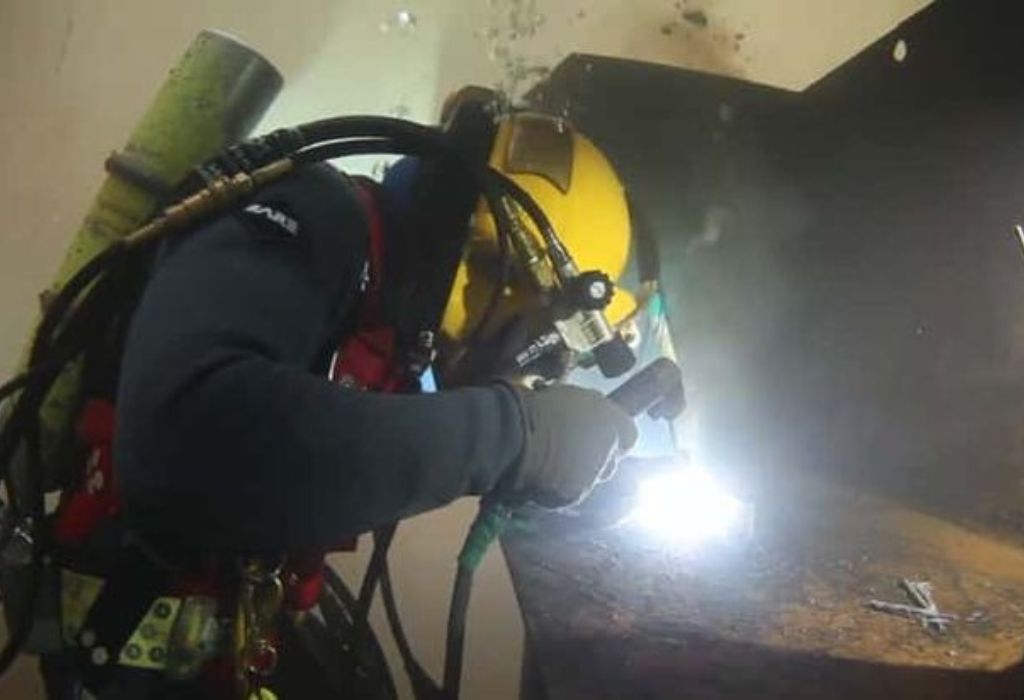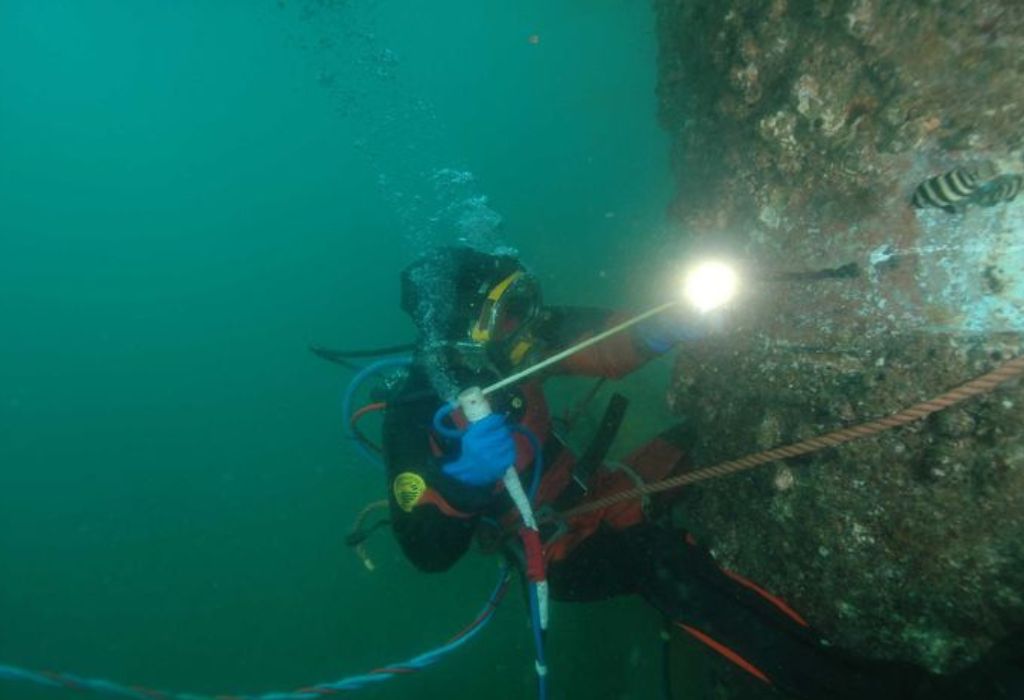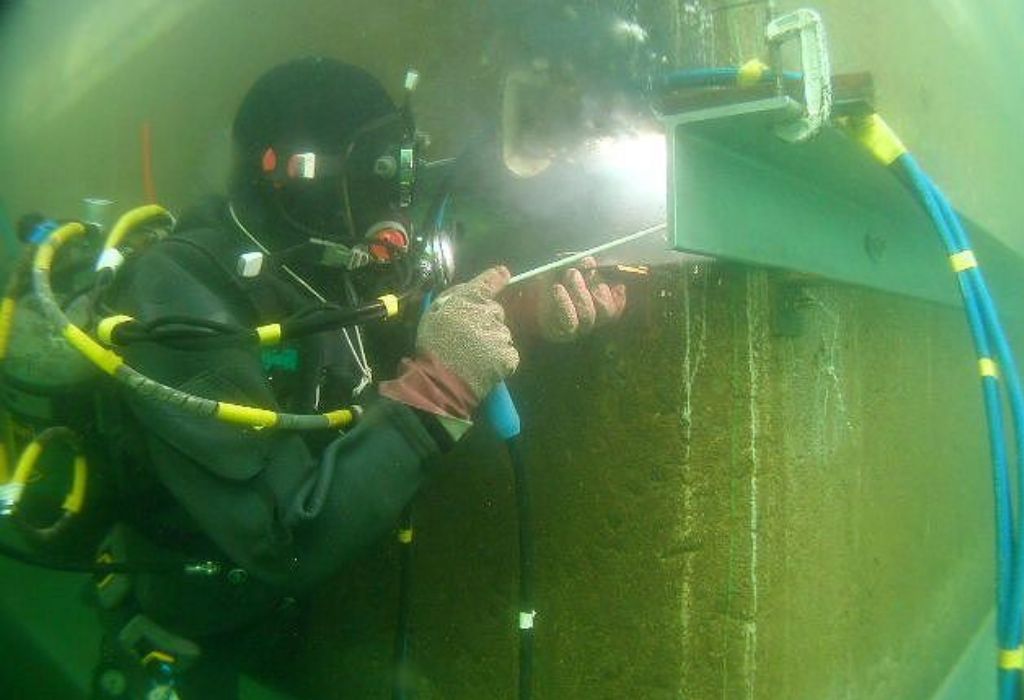Beneath the ocean’s surface, where visibility fades and pressure builds with every meter, a select group of welders take on one of the most hazardous jobs in the world — underwater welding.
The work may seem thrilling and rewarding, but it’s also filled with unseen dangers that few outside the industry truly understand.
Every dive into the depths brings new challenges: unstable structures, unpredictable water currents, and a welding arc that must perform flawlessly in an environment that’s both conductive and unforgiving.
According to the U.S. Bureau of Labor Statistics, underwater welding is consistently ranked among the top 10 most dangerous professions, with fatality rates estimated between 6 to 15 times higher than those of land-based welders (source).
The combination of electricity and water, two forces that should never meet, creates an ever-present risk of electrocution.
At the same time, welders face extreme pressure variations that can lead to decompression sickness, also known as “the bends,” a condition that can cause paralysis or even death if not managed properly.
In addition, gas explosions, drowning, and hypothermia lurk as constant threats in the cold, dark depths.
Yet despite these dangers, underwater welding remains essential to industries like offshore oil, ship repair, and underwater construction, where maintaining or restoring critical infrastructure keeps economies running. Each weld made beneath the surface represents a balance between skill, courage, and risk — a testament to human determination to master even the most hostile environments.
In this article, we’ll explore what are the dangers of underwater welding, uncovering the science behind each hazard, how professionals mitigate them, and why this career, though perilous, continues to attract those who seek both challenge and adventure beneath the waves.
What Is Underwater Welding & Why It’s Unique

Underwater welding, also known as hyperbaric welding, is the process of joining metal structures while submerged in water. It combines the complex techniques of traditional welding with the high-pressure challenges of commercial diving. The welder, equipped with diving gear and electrical equipment, must maintain control over the arc, temperature, and environment — all while operating in an oxygen-deprived and pressure-heavy space.
There are two primary methods: wet welding and dry (hyperbaric) welding. In wet welding, the diver works directly in the water, using waterproof electrodes and insulated tools to make repairs on pipelines, ships, or underwater structures. In dry welding, the work is done inside a sealed habitat or chamber filled with a controlled gas mixture, providing a safer but more expensive alternative.
Unlike traditional welding, underwater welding involves additional variables such as water conductivity, pressure, visibility, and temperature. These factors significantly increase the risk and complexity of every task. Even minor mistakes — like a faulty cable or poor grounding — can have catastrophic consequences underwater.
Moreover, the environment is constantly shifting. Visibility can drop within seconds, currents can push the diver off balance, and communication with surface teams may be delayed. This makes situational awareness and technical precision critical skills for underwater welders.
Despite these difficulties, underwater welding is vital for global industries — from maintaining offshore oil rigs to repairing naval ships and underwater pipelines. The work ensures that essential infrastructure remains functional, but it also demands an extraordinary level of training, discipline, and risk tolerance.
Why is underwater welding considered more dangerous than surface welding?
Because it combines electrical hazards with high water pressure, limited visibility, and gas explosion risks.
What is the main difference between wet and dry underwater welding?
Wet welding occurs directly in water, while dry welding happens inside a pressurized chamber that isolates the work area.
What industries rely most on underwater welding?
Oil and gas, maritime repair, power generation, and underwater construction.
How deep can underwater welders work?
Typically between 30 to 300 feet, depending on certification and equipment.
Can robotic systems replace underwater welders completely?
Not yet — automation is growing, but complex human judgment is still required for precision and repair work.
Electrical Shock and Electrocution
When electricity and water meet, danger is inevitable. Underwater welders work with electrical currents while completely surrounded by a conductive medium, making electrocution one of the most serious risks. Even a small insulation failure can allow current to pass through water, instantly shocking or killing the diver.
The welding arc used underwater typically operates between 300–400 amps, enough to cause fatal injury. While divers use DC (direct current) systems and waterproof electrodes to minimize risk, faults in grounding or damaged cables can still expose them to deadly electric leakage.
Modern systems include circuit breakers, ground fault interrupters, and insulated equipment, yet the environment remains unpredictable. Corrosion, saltwater, and pressure can degrade safety systems faster than on land.
How do underwater welders avoid electrocution?
By using direct current (DC), waterproof electrodes, proper insulation, and continuous monitoring from surface teams.
Can a small voltage leak cause harm underwater?
Yes. Even low voltage in water can be fatal due to its high conductivity and full-body immersion.
Are modern underwater welding tools completely safe?
No. Technology reduces risk, but complete safety is impossible in such a conductive environment.
How often do electrocution accidents happen?
While rare with proper protocols, they account for a significant portion of underwater welding fatalities.
Decompression Sickness and Pressure Hazards
Working deep underwater means exposure to extreme pressure. The deeper the welder dives, the higher the external pressure on their body. When ascending, gas bubbles can form in the bloodstream — a condition known as decompression sickness (DCS) or “the bends.”
This happens when dissolved nitrogen escapes too quickly from the diver’s body during rapid ascent. Symptoms include joint pain, dizziness, paralysis, and even death. In severe cases, arterial gas embolism can block blood flow to vital organs.
To prevent this, divers follow strict decompression schedules and rest inside decompression chambers after dives. However, any deviation, emergency ascent, or equipment malfunction can trigger a life-threatening event.
What causes decompression sickness in underwater welding?
Rapid ascent without proper decompression stops, causing nitrogen bubbles to form in tissues and blood.
How can it be prevented?
By following dive tables, limiting depth duration, and using decompression chambers after dives.
What are the symptoms of the bends?
Severe pain, fatigue, numbness, dizziness, or breathing difficulty.
Is decompression sickness fatal?
Yes — if untreated, it can lead to paralysis or death within hours.
Gas Pocket Explosions and Combustion Hazards

Underwater welding produces hydrogen and oxygen gases through the process of electrolysis. When these gases accumulate in enclosed areas or pockets, even a single spark from the arc can ignite a violent explosion.
These gas pockets often form under structures, inside crevices, or in old pipelines being repaired. The mix of flammable gases, high temperature, and limited escape routes creates a deadly combination.
To reduce this risk, welders use controlled ventilation, inert gas mixtures, and continuous monitoring of gas accumulation. However, unpredictable conditions can still lead to dangerous gas buildups during long welding sessions.
Why do gas explosions occur during underwater welding?
Because hydrogen and oxygen produced by electrolysis can ignite under pressure.
How do divers prevent explosions?
By ventilating areas, using gas sensors, and controlling arc temperature and position.
What are the effects of such explosions?
Severe burns, shockwaves, or fatal injuries.
Is wet welding more prone to explosions than dry welding?
Yes — because gases cannot escape easily in open water environments.
Drowning and Asphyxiation
Even skilled divers face the constant risk of drowning during underwater welding. Equipment failure, tangled hoses, disorientation, or fatigue can all contribute to accidents. If a diver’s oxygen supply is cut off, they have only seconds to react.
Asphyxiation can also occur when breathing gas systems fail or when toxic gases displace oxygen inside a hyperbaric chamber. In addition, panic or vertigo caused by low visibility can lead to confusion, making escape nearly impossible.
Strict safety monitoring, redundant air systems, and real-time communication are vital to prevent such tragedies. Surface teams must be ready to respond immediately if a diver becomes unresponsive.
What is the main cause of drowning in underwater welding?
Equipment failure, fatigue, or entanglement during the dive.
Can divers lose consciousness underwater?
Yes — lack of oxygen or sudden panic can cause blackouts.
How do teams prevent drowning incidents?
Through regular gear checks, buddy systems, and constant communication.
Thermal Burns, Barotrauma, and Tissue Damage
The welding arc can reach temperatures above 10,000°F (5,500°C), enough to cause severe burns even underwater. Steam from heated water and molten metal droplets can scald exposed skin or penetrate damaged gear.
Additionally, barotrauma — injury caused by rapid pressure changes — can affect the ears, sinuses, and lungs. Divers often experience ear pain, sinus bleeding, or even lung rupture if they ascend too quickly or fail to equalize pressure.
To mitigate this, welders wear flame-resistant drysuits, maintain controlled breathing rates, and use pressure-regulated helmets.
How do burns occur underwater?
From contact with hot metal, arc radiation, or steam during welding.
What is barotrauma in diving?
Tissue injury from sudden pressure change, often affecting lungs or ears.
Can underwater welders suffer long-term damage?
Yes — repeated exposure may cause hearing loss, sinus damage, or scarring.
Hypothermia and Cold Water Stress
Water extracts body heat 25 times faster than air. Even in moderate temperatures, prolonged exposure can cause hypothermia, a condition where the body loses heat faster than it can produce.
Cold water reduces dexterity, slows reflexes, and clouds judgment — all of which can turn minor issues into deadly mistakes. Welders combat this by wearing insulated suits, using heated dive systems, and limiting dive duration.
However, sudden equipment malfunction or long decompression stops can still expose divers to dangerously low temperatures.
Why is hypothermia so dangerous underwater?
Because it impairs decision-making and physical control, increasing accident risk.
At what temperature can hypothermia set in?
Even at 50°F (10°C) water temperature, it can occur within an hour.
How do divers protect themselves?
By using drysuits, heat packs, and monitoring body temperature continuously.
Environmental and Site Hazards
The underwater world is unpredictable. Poor visibility, strong currents, and marine life can create hazards even before welding begins. Limited light can make it difficult to locate joints, inspect cracks, or navigate structures safely.
Some marine organisms, such as jellyfish or sea urchins, can cause painful stings, while large predators in open waters pose additional threats. Entanglement in debris, falling objects, or collapsing structures can trap divers without warning.
Because of these conditions, continuous situational awareness, stabilization lines, and constant surface communication are mandatory during every dive.
What environmental dangers do underwater welders face?
Poor visibility, strong currents, and encounters with marine life.
Can marine life attack divers?
While rare, some species can be aggressive or territorial.
How do divers stay safe in poor visibility?
By using guide lines, lights, and maintaining fixed positions relative to structures.
Safety Measures and Risk Mitigation

Despite all these hazards, underwater welding can be performed safely when proper procedures are followed. The industry has developed strict standards for training, equipment, and dive management to reduce risks.
Divers undergo commercial diving certification and underwater welding training, covering electrical safety, pressure control, and emergency response. Equipment is regularly inspected for corrosion, insulation damage, and air leaks.
Modern operations also include real-time video monitoring, gas sensors, and automated decompression controls. Every dive plan outlines time, depth, and emergency protocols in detail.
The use of hyperbaric welding chambers, ROV (remotely operated vehicle) systems, and robotic assistance is also growing, minimizing human exposure to danger zones.
What training is required for underwater welders?
Commercial diving certification plus specialized welding safety training.
How do teams prepare for emergencies?
By rehearsing rescue drills, maintaining communication, and using backup systems.
Are robotic welders replacing humans?
Not fully — human expertise is still needed for precision tasks.
Emerging Technologies and Future Safety Trends
Innovation is slowly transforming the industry. Robotic welding systems, AI-powered monitoring, and dry hyperbaric habitats are making operations safer and more efficient.
Researchers are developing smart wetsuits with temperature sensors, wireless communication systems, and real-time gas monitoring tools to alert teams before conditions become dangerous.
In the future, remote-operated welding drones could perform deep-sea repairs where human divers cannot safely go, significantly reducing fatality rates.
How is technology changing underwater welding safety?
Through automation, AI monitoring, and improved equipment insulation.
Will robots fully replace divers?
No, but they’ll handle high-risk or deep-sea jobs.
What innovations are improving diver protection?
Smart suits, advanced helmets, and hyperbaric chamber technology.
Conclusion
Underwater welding stands as one of the most challenging and dangerous professions on Earth. From electrical hazards and decompression sickness to gas explosions and environmental threats, each dive demands absolute precision and respect for safety protocols.
Yet, with the right training, equipment, and mindset, these risks can be managed — allowing welders to perform critical work that keeps the world’s marine infrastructure alive.
Understanding what are the dangers of underwater welding isn’t just about acknowledging risk — it’s about recognizing the expertise and courage of those who face the ocean’s depths to build, repair, and protect what lies beneath.

I’m Darrell Julian, the founder, lead writer, and hands-on welding enthusiast behind ArcWeldingPro.com. With more than 15 years of real-world welding experience, I created this platform to share what I’ve learned in the field, in the shop, and in the heat of the arc.


